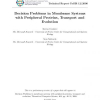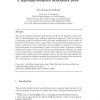TCS
2008
13 years 4 months ago
2008
F. Labelle and J. Shewchuk [3] have proposed a discrete definition of anisotropic Voronoi diagrams. These diagrams are parametrized by a metric field. Under mild hypotheses on the...
TCS
2008
13 years 4 months ago
2008
TCS
2008
13 years 4 months ago
2008
The object of this paper is to appreciate the computational limits inherent in the combinatorics of an applied concurrent (aka agent-based) language . That language is primarily m...
TCS
2008
13 years 4 months ago
2008
Beta-binders is a recent process calculus developed for modelling and simulating biological systems. As usual for process calculi, the semantic definition heavily relies on a stru...
TCS
2008
13 years 4 months ago
2008
This article presents formalized intuitionistic proofs for the polyhedra genus theorem, the Euler formula and a sufficient condition of planarity. They are based on a hypermap mod...
TCS
2008
13 years 4 months ago
2008
Interpretation and Types for Systems Biology Fran
TCS
2008
13 years 4 months ago
2008
Density elimination, a close relative of cut elimination, consists of removing applications of the Takeuti-Titani density rule from derivations in Gentzen-style (hypersequent) cal...
TCS
2008
13 years 4 months ago
2008
TCS
2008
13 years 4 months ago
2008
In this paper, we present a fully automatizable approach to detecting loops in standard term rewriting. Our method is based on semi-unification and an unfolding operation which pr...
TCS
2008
13 years 4 months ago
2008
In this paper, we study the conditions in which the (1+1)-EA compares favorably to other evolutionary algorithms (EAs) in terms of fitness function distribution at given iteration...


